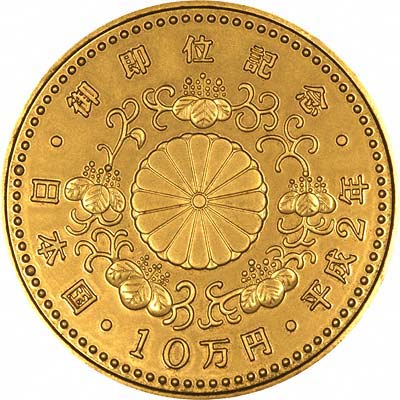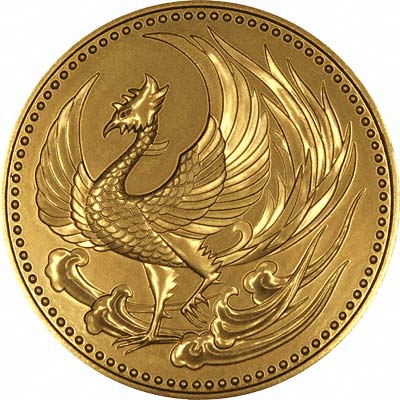|
The Case of the Chrysanthemum Coins
In 1990, the Japanese Government wrongly accused a British dealer of dealing in large quantities of counterfeit Japanese gold coins. the case was still rumbling on in 1992.
Coin Fraud Case Widens
Reuters
Published: February 13, 1990
TOKYO, Feb. 12 — Three Japanese detectives left today for Switzerland to investigate possible Swiss links to a huge counterfeit operation that flooded Tokyo with bogus Emperor Hirohito gold coins, the police said.
The police suspect at least two Swiss brokers were involved in shipping the fake pieces, 103,000 of which have been imported by Tokyo dealers. The coins, each with a face value of $700, had a total market price of $72 million. The face value of the coins substantially exceeds the value of the gold in the coins.
Paul Davies, a British coin dealer who came to Tokyo voluntarily to help the police investigate the fraud, told the Kyodo news agency that he had bought the Hirohito pieces from a Swiss dealer.
Mr. Davies said he continued to deal in the coins only because the Bank of Japan was willing to redeem them. He was quoted as saying, ''I still believe the coins were real.''
The press in Japan has reported that a Swiss bank was also involved, but the police refused to comment.
The police said the counterfeiters might have used as much as two tons of pure gold, worth more than $27 million, to mint the coins.
Numismatic Mystery: A New Turn in the Case of the Chrysanthemum Coins
By JAMES STERNGOLD
Published: May 20, 1992
TOKYO, May 19 — After two years of Government leaks and speculation, one of Japan's most intriguing financial whodunits has entered a new chapter.
A lawsuit filed here this morning demands resolution of the mystery: Did the Japanese police uncover the biggest and most well-financed counterfeit operation in history, or instead commit a major blunder by seizing 103,000 genuine gold coins as fake and incorrectly accusing a Briton of dealing in them?
Paul Davies, the British coin dealer at the center of this strange affair, insists that several thousand of the coins confiscated from him two years ago are genuine. In his suit, Mr. Davies demands that the coins be returned, or that he be paid for their full value, plus interest.
The suit is intended to force the police to do something they have failed to do for the last two years -- prove the gold coins are indeed counterfeits.
"We cannot comment on what our position will be in court because we have not seen the petition yet," said Akira Ono, deputy director of the Finance Ministry's treasury division. "But on the question of whether the coins are counterfeit or not, there is no question about it. They are clearly counterfeit."
The mystery first became public in February 1990, when the Finance Ministry said it had discovered 103,000 counterfeit gold coins. They are said to have appeared among the 11 million special coins the Government minted in 1986 and 1987 to commemorate the 60th year of the reign of Emperor Hirohito, known posthumously as Emperor Showa.
The coins actually served several purposes. They were regarded as a fitting way to mark the Emperor's long rule and Japan's emergence in the 1980's as an economic powerhouse. But they were also a major money-making enterprise. An Official Gold Rush
There was a gold fever in Japan at that time, and the coins, slightly larger than a quarter, with the Imperial chrysanthemum symbol stamped on one side, were eagerly snapped up by collectors.
The Finance Ministry took advantage of that fervor by giving each coin a face value of 100,000 yen (about $778 at today's currency rates), the price at which they were sold and could be redeemed. But the coins included what was then only about 40,000 yen worth of gold each. That meant the Government earned about 60,000 yen on each coin it sold, a total of some $5 billion if all went well.
Gold Coin Redemptions Bamboozle Japanese Government
As with many modern issue commemorative coins, the novelty value wore off after a few years. By 1990, it seems there were quite significant quantities of the Hirohito gold coins on the secondary market.
When first issued in 1986, the gold content was worth about Y40,000 per coin against a face value of Y100,000; by 1987 this had increased slightly to over Y41,000 per coin. In 1990, a combination of a lower gold price (in dollars), and a higher yen exchange rate against the US dollar, had reduced the intrinsic gold content of each coin to under Y36,000 per coin.
While the Japanese Central Bank had been happy to make a profit of around 60,000 per coin when they were issued, they were now faced with an apparent loss on redemption of just over Y64,000 per coin.
It is our guess that somebody in the Japanese Central Bank, Treasury, or other part of the Government got worried about the quantities of gold coins being redeemed, and, knowing little about coins, suspected that they must be fakes.
On this basis, they seized a batch of around 3,000 coins stating them to be counterfeit.
Losing Face - or Redeeming at Face
Most people do not like to be forced to lose face and admit to being wrong. Governments and government officials particularly do not like to admit mistakes, Japanese people do not like to lose face, so it is not surprising that once their pronouncement had been made, that the coins were fake, nobody in the Japanese Central Bank, Government, or Police were prepared to back down and admit they were wrong.
In 1992, the British dealer, Paul Davies issued legal proceedings against the Japanese authorities to prove the coins were counterfeit, or else to release and redeem them. We do not know the formal conclusion of the case, but we do know that the British dealer won the day, and eventually got paid out.
Japan Silver and Base Metal Coins
For silver and base metal coins of Japan, please look at our original Chard Coins website.
|
|

Obverse of 1990 Japanese 100,000 Yen
Countries Index

Reverse of 1990 Japanese Gold 100,000 Yen
World Gold Coins
|


